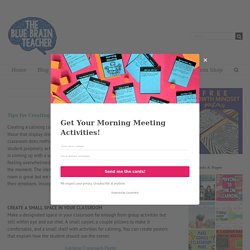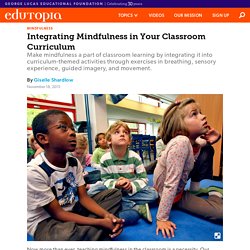

Create a Calming Corner in Your Classroom. Creating a calming corner in your classroom is useful for many students especially those that display disruptive behavior.

Placing disruptive students outside of the classroom does nothing to help the situation but might make matters worse if the student purposely acts disruptive in order to leave the classroom. A better solution is coming up with a safe place in the classroom a student might go if they are feeling overwhelmed, angry, sad or any other emotion that they cannot manage at the moment. Effects of a MBE Program (1) When Mindfulness Meets the Classroom (1) Integrating Mindfulness K 12 (5) Mindfulness A Teachers Guide. 10 Mindfulness activities for the classroom. In the most recent issue of English Teaching Professional (Issue 116), in a curious coincidence, both myself and Tanja Jankovič wrote about the topic of mindfulness and the importance for both teachers and students to cultivate mindfulness.

One way to do this is to spend some time in the classroom offering mindfulness training. I come from a family with Buddhist influences and a strong tradition of meditation and Ki-Aikido and growing up, discussions about meditation, Zen Buddhism, Qi/Ki energy were commonplace. In my 20s, I spent several years practising certain meditation techniques that have led to an increased awareness of the importance of mindfulness in daily life. To add to Tanja’s wonderful list of classroom activities to promote mindfulness amongst her young learners, I’d like to share some of activities that can be both used in and out of the classroom for both adults and children. 1. 2. 3. 4. 5. 6. 7. 8. Integrating Mindfulness in Your Classroom Curriculum. Now more than ever, teaching mindfulness in the classroom is a necessity.

Our children are stressed and anxious. Teachers and parents are stressed and anxious, too. Our lives are busy, and we often find our thoughts buzzing over the past or worrying about the future. We need mindfulness because it teaches us to live in the present moment, enjoying and experiencing what’s in front of us. Educators know that children learn best when they are comfortable, safe, and relaxed. Mindfulness in the Classroom. Carole Clancy, who supervises special education for the Lancaster, Pa., city schools, had a serious problem: She couldn’t hold on to her teachers.

The students in special ed classes were distracted and disruptive. “They had the reputation of being unmanageable and out of control,” she says. How to Create a Calm Down Corner in 5 Easy Steps. Do you have students who have a hard time controlling their emotions?

Mindfulness meditation may ease anxiety, mental stress. My mom began meditating decades ago, long before the mind-calming practice had entered the wider public consciousness.

She liked to quote sayings from Thich Nhat Hanh, a Zen Buddhist monk known for his practice of mindful meditation, or “present-focused awareness.” Although meditation still isn’t exactly mainstream, many people practice it, hoping to stave off stress and stress-related health problems. Mindfulness meditation, in particular, has become more popular in recent years.
The practice of mindful meditation involves sitting comfortably, focusing on your breathing, and then bringing your mind’s attention to the present without drifting into concerns about the past or future. (Or, as my mom would say, “Don’t rehearse tragedies. But, as is true for a number of other alternative therapies, much of the evidence to support meditation’s effectiveness in promoting mental or physical health isn’t quite up to snuff. Dr. “If you have unproductive worries,” says Dr. Dr. Tolerance. When Mindfulness Meets the Classroom. A Space Apart. Maybe the greatest thing about Humboldt State University’s (HSU) new, meant-to-be-shared meditation room is that everyone who uses it seems to be getting along.

“I’m actually surprised,” says Cyril Oberlander, who directs the HSU library in Arcata, California. “No reported conflicts of use at all. De-Stress Before EOY Exams – The Port Press. Decoration or distraction: the aesthetics of classrooms matter, but learning matters more. On a recent holiday to Greece, my 30-year-old daughter took a trip down memory lane and visited her old primary school.

She posted a photo to Instagram captioned: It might look like a jail but at least the view was good. The view from the classrooms across the bay to the mountains beyond is indeed mesmerising, but the building does look like a grim correctional facility. We had moved to Greece, from Australia, when she was in Year 4. 12 Ways to Upgrade Your Classroom Design. Where Healing Happens: Librarians Adopt Trauma-Informed Practices To Help Kids. Bringing Mindfulness into Schools.
Dos and Don’ts of Classroom Decorations. Heavily decorated classrooms can bombard students with too much visual information, interfering with their memory and ability to focus, a new study finds.

This is just the latest study to examine the relationship between classroom environment and students’ executive functions, which include skills like memory, attention, and self-regulation. While teachers have good intentions when decorating, many classrooms end up being “sensory-rich” in a way that “could hamper children’s learning gains rather than help,” according to psychologists Pedro Rodrigues and Josefa Pandeirada, who coauthored the study. Eight Tips for Teaching Mindfulness in High School. When I walked in to teach my first mindfulness class at a charter high school in Oakland, no one seemed interested.

One student was sleeping in his chair; a few kids were messing around in the classroom. Our Mindful Mondays series provides ongoing coverage of the exploding field of mindfulness research.© Dan Archer Everyone looked at me like I was in the wrong place. How to Avoid A Poorly Designed School Mindfulness Program. In the UK, it was recently announced that the national government will put public money into mindfulness in education for the first time. One hundred and fifty schools will take part in a trial training program as part of a wider piece of research into mental health and wellbeing programs.
This new level of interest is welcome, but it does bring to light some critical tensions that could arise when designing and implementing programs in schools with tight resources. Watch "Arrive" - How A Mindful Minute Helps Students Arrive in the Classroom. Making Time for Mindfulness. Not knowing the answer to a question when you’re called on in front of the entire class. Forgetting your homework. The kid behind you pulling your hair. School poses a lot of stressful moments, but how children (and teachers) react to them can make all the difference. A new study suggests that mindfulness education — lessons on techniques to calm the mind and body — can reduce the negative effects of stress and increase students’ ability to stay engaged, helping them stay on track academically and avoid behavior problems.
Article: Our Students’ Minds Matter: Integrating Mindfulness Practices into Special Education Classrooms. Mindfulness in High School. Some classrooms have a certain aura, don’t they? When you enter, there’s a sense of peace, community, clarity, and active presence from all stakeholders. That is the kind of classroom I want to create, and one way I’ve sought to accomplish this is by taking a course in mindfulness for educators. Since then, I have led daily mindful moments in all of my classes. It’s been transformative for classroom culture.